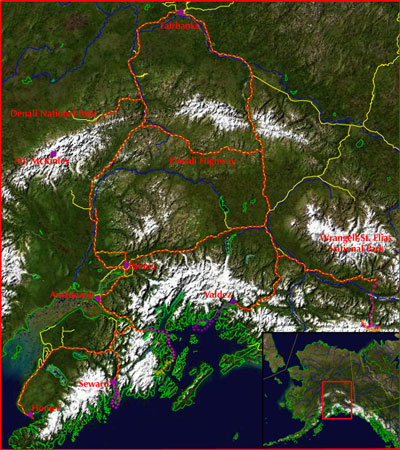So here's the final trip overview. We drove most of the road system, but never got too far off the roads (relatively speaking). Even so, we managed to get away from crowds for almost the entire trip.
There's a bigger picture here.
If I were planning it again, I'd get the Alaska Atlas and Gazetteer before I started planning at all. Or perhaps the Alaska Topo series CDs, if I were feeling flush. If I had the money, I'd fly north, and probably do more flying in general. I'd take the ferry out to the aleutian chain and explore there a bit, and I'd try to get to the inside passage. And I'd give myself 5 more days to camp out on whale bay and wait for the humpbacks to come to me!
It was a fabulous trip overall. I was surprised at how much I loved the long days. I expected it to be kind of tiring to have the sun up all the time, and to try to get to sleep while the sun was up, but instead I found it very energizing. And, it meant that Alaska was on my kind of schedule -- things opened late and stayed open late. It seemed pretty standard that many things didn't open until 10am (including the Anchorage City Park, which I couldn't figure out).
There was a heat wave just before we left, and the temperature in Anchorage spiked to 85 degrees... one degree below the record high. (It gets considerably hotter in Fairbanks and the Interior.) This caused lots of consternation and discomfort among residents! On the other hand, I checked the weather in McCarthy on the first days of September, and saw that the highs were in the upper 40s, and the lows dipped down to 21. Hello, winter! I guess we all adjust to our environment.
I expected more variety in the terrain and vegetation, but the tradeoff for lack of diversity was a pretty impressive topography. I guess you can't expect that much diversity in a land of such "new" geology.
I already mentioned that only 1% of Alaska's land is privately owned; only 1/20th of one percent is developed, which makes sense when there are 600,000 residents in a space that accounts for 20% of the US land mass. Meanwhile, 5% of Alaska is covered in glaciers... which amounts to roughly one glacier for every six residents! (Glaciers requiring, of course, considerably more space than people.)
Enough summarizing! I hope you enjoyed the pictures...
(And if you're just arriving, go to the explanation of how to navigate this navigationally-challenged site so you don't end up reading the narrative backwards!)





